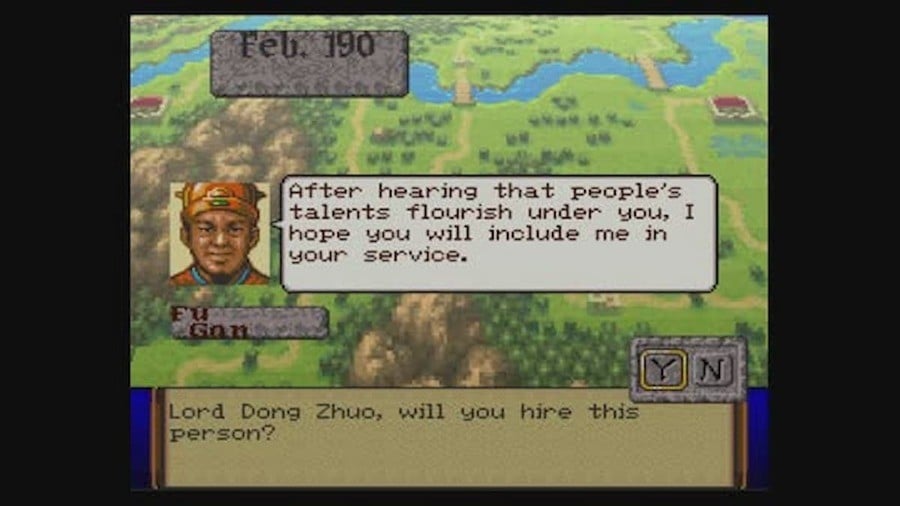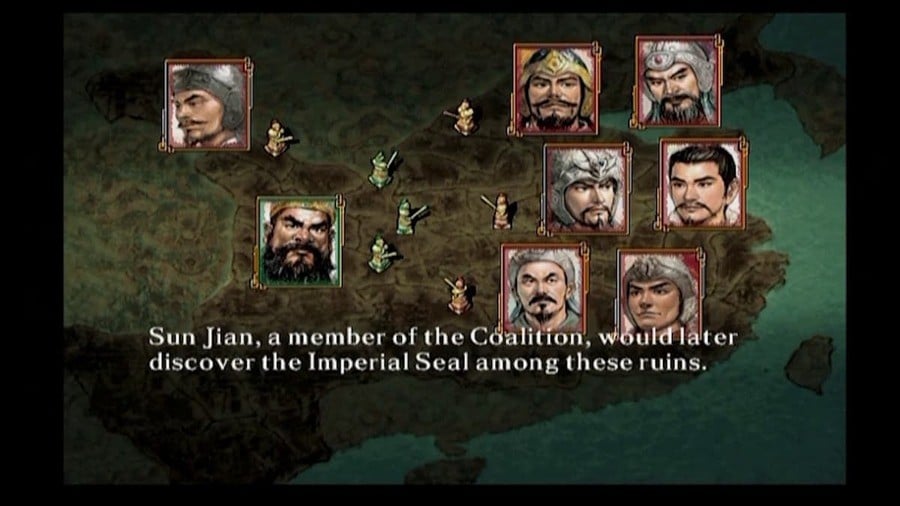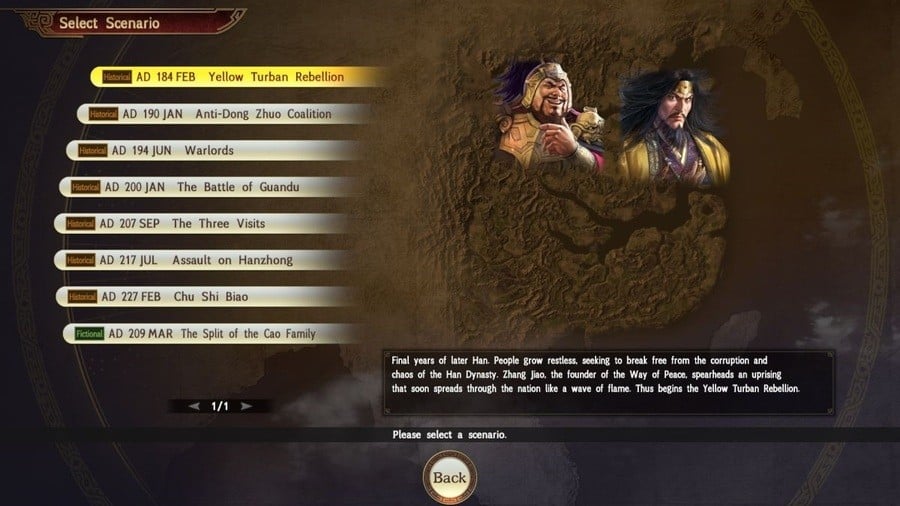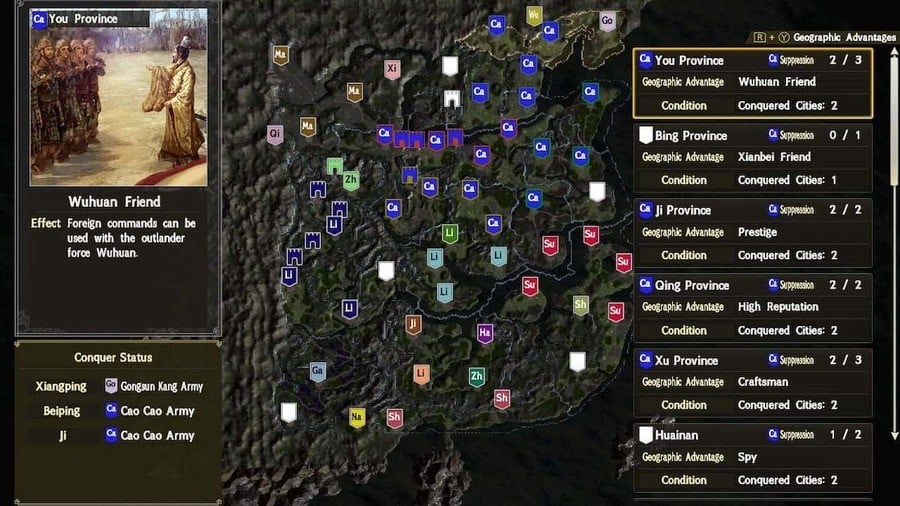
This series has always been one for hardcore strategy fans. Even the original, which is understandably simple by today’s standards, required players to manage multiple systems. There were natural disasters — droughts and floods — to contend with between wars with neighbours. Interestingly, the game gave almost equal weight to the loyalty you earned from your officers as well as the peasants under your rule. Keeping the people happy and fed was just as key to ensuring a long rule as gaining new territory through conquest.

Battles in the early games played out in simple 8-bit maps, but it was the political intrigue that gripped players from the start. Characters would approach with seemingly benevolent intentions only to swiftly turn on you. It was a groundbreaking achievement on the hardware and made Romance of the Three Kingdoms the deepest strategy game on consoles at the time. Successive entries would build on the original’s basic structure, expanding the features and upgrading the visuals without deviating far from the grand strategy premise. Romance of the Three Kingdoms II (NES, 1990; SNES, 1991) introduced a reputation system that could increase or decrease officer loyalty depending on your actions and Romance of the Three Kingdoms III (SNES, 1992/3) would expand the number of cities to 48, but these were small changes in the successful formula.
1994’s Romance of the Three Kingdoms IV would mark the last entry on a Nintendo console for more than a decade as the series would skip both the Nintendo 64 and GameCube in favour of Sony hardware. It wasn’t until the unexpected success of the Wii that Romance of the Three Kingdoms XI was brought back to Nintendo home consoles. By then, the series had undergone significant change.
Spawning a Dynasty
15 years after the original game’s release, in the ‘gap’ between Nintendo entries, Romance of the Three Kingdoms VII marked perhaps the biggest deviation in the series’ design.
“In the case of the Romance of the Three Kingdoms series, we had been working to refine the kingdom management up to Romance of the Three Kingdoms VI,” explains Romance of the Three Kingdoms XIV producer Echigoya Kazuhiro. “In Romance of the Three Kingdoms VII, there was a major change and the direction was adjusted into officer play, and since then, the direction of the games alternate between kingdom management and officer play.”

That shift in focus from big-picture management toward individual characters and their achievements brought about the ability to create your own officers. By VIII, you could create custom characters alongside friends, forging – and likely destroying – friendships and alliances in both the virtual and real worlds. As Echigoya-san mentions, from then on the series would shift back and forth between kingdom and officer management, but going forward there would always be a greater focus on the characters of Romance of the Three Kingdoms.
Part of that shift may have been down to the release of Dynasty Warriors 2 in 2000. This spin-off from the Romance of the Three Kingdoms series introduced a much greater focus on combat, with players hacking and slashing their way through 1000s of enemies on elaborate stages. The characters from the period, who had previously been relegated to talking heads on text boxes, were suddenly far more prominent and full of energy.
The accessible, hack-and-slashing Dynasty Warriors franchise would slowly eclipse Romance of the Three Kingdoms in popularity, spawning its own spin-offs and crossovers and eventually becoming Koei’s best-selling series by 2008. The existence of this action-focused series would turn out to be a blessing for historical strategy fans. Koei had something to offer fans wanting pure combat, allowing Romance of the Three Kingdoms to focus on strategy. The two series would occasionally share assets and even crossover in the form of the Dynasty Tactics games on PS2, but their targets primarily remained separate over the years.
A Win-Win Scenario

Regardless of the focus of the games, one of the core gameplay features of the Romance of the Three Kingdoms series has always been the use of ‘Scenarios’, a feature that Ito Yuinori believes define the series.
“The system of these scenarios can start from the first chapter of the story, and thus it is a groundbreaking invention in my opinion,” he says. “In that sense, I cannot imagine a Romance of the Three Kingdoms game with the current system but without any of these scenarios.”
Because the Three Kingdoms War lasted, with various peaks and troughs, for 60 years, there are plenty of key points and engagements. These Scenarios give players a starting point, allowing you to jump into the war at the most interesting moments and situations from a gameplay perspective.
Each game typically offers between six and ten scenarios to choose from, ranging from the outbreak of the war to key moments from the Romance of the Three Kingdoms novel. Liu Bei’s exile in Xinye in 201 AD features multiple times, as does Jiang Wei’s rise to prominence in Shu. You are dropped into a ‘snapshot’ of history, with borders and characters presented as they were at that time. However, where they go from there is completely up to you.
An Eventual Return to the West
Like many niche Japanese game series, Romance of the Three Kingdoms has had an inconsistent Western release schedule over the years. Some like XI and XII, which appeared on Wii and Wii U respectively, would never receive an official English translation, and several would only grace Nintendo hardware in the form of Japan-only portable versions years after their initial release. The most recent mainline entry in the series (Romance of the Three Kingdoms XIV, released in North America and Europe in February 2021) marked the first time since IV back in 1995 that a Nintendo console received an English-language release in the West.

With no new games announced at the time of writing, it seems unlikely — though not impossible — that the Switch will see another entry in this series which has been rewriting history for almost as long as Nintendo has been in the console business. Perhaps we’re better off hoping that some of the early titles, which are increasingly difficult to find, will find a home on the Switch Online service.
In the West, Romance of the Three Kingdoms has always been a hidden gem in Koei Tecmo’s arsenal, luring in fans of grand strategy with deep, challenging gameplay set in one of the most pivotal moments in human history. It’s a grand old tome and one with many pages left to turn; we hope to experience more of them on Nintendo platforms in the future.
This series has always been one for hardcore strategy fans. Even the original, which is understandably simple by today’s standards, required players to manage multiple systems. There were natural disasters — droughts and floods — to contend with between wars with neighbours. Interestingly, the game gave almost equal weight to the loyalty you earned from your officers as well as the peasants under your rule. Keeping the people happy and fed was just as key to ensuring a long rule as gaining new territory through conquest.

Battles in the early games played out in simple 8-bit maps, but it was the political intrigue that gripped players from the start. Characters would approach with seemingly benevolent intentions only to swiftly turn on you. It was a groundbreaking achievement on the hardware and made Romance of the Three Kingdoms the deepest strategy game on consoles at the time. Successive entries would build on the original’s basic structure, expanding the features and upgrading the visuals without deviating far from the grand strategy premise. Romance of the Three Kingdoms II (NES, 1990; SNES, 1991) introduced a reputation system that could increase or decrease officer loyalty depending on your actions and Romance of the Three Kingdoms III (SNES, 1992/3) would expand the number of cities to 48, but these were small changes in the successful formula.
1994’s Romance of the Three Kingdoms IV would mark the last entry on a Nintendo console for more than a decade as the series would skip both the Nintendo 64 and GameCube in favour of Sony hardware. It wasn’t until the unexpected success of the Wii that Romance of the Three Kingdoms XI was brought back to Nintendo home consoles. By then, the series had undergone significant change.
Spawning a Dynasty
15 years after the original game’s release, in the ‘gap’ between Nintendo entries, Romance of the Three Kingdoms VII marked perhaps the biggest deviation in the series’ design.
“In the case of the Romance of the Three Kingdoms series, we had been working to refine the kingdom management up to Romance of the Three Kingdoms VI,” explains Romance of the Three Kingdoms XIV producer Echigoya Kazuhiro. “In Romance of the Three Kingdoms VII, there was a major change and the direction was adjusted into officer play, and since then, the direction of the games alternate between kingdom management and officer play.”

That shift in focus from big-picture management toward individual characters and their achievements brought about the ability to create your own officers. By VIII, you could create custom characters alongside friends, forging – and likely destroying – friendships and alliances in both the virtual and real worlds. As Echigoya-san mentions, from then on the series would shift back and forth between kingdom and officer management, but going forward there would always be a greater focus on the characters of Romance of the Three Kingdoms.
Part of that shift may have been down to the release of Dynasty Warriors 2 in 2000. This spin-off from the Romance of the Three Kingdoms series introduced a much greater focus on combat, with players hacking and slashing their way through 1000s of enemies on elaborate stages. The characters from the period, who had previously been relegated to talking heads on text boxes, were suddenly far more prominent and full of energy.
The accessible, hack-and-slashing Dynasty Warriors franchise would slowly eclipse Romance of the Three Kingdoms in popularity, spawning its own spin-offs and crossovers and eventually becoming Koei’s best-selling series by 2008. The existence of this action-focused series would turn out to be a blessing for historical strategy fans. Koei had something to offer fans wanting pure combat, allowing Romance of the Three Kingdoms to focus on strategy. The two series would occasionally share assets and even crossover in the form of the Dynasty Tactics games on PS2, but their targets primarily remained separate over the years.
A Win-Win Scenario

Regardless of the focus of the games, one of the core gameplay features of the Romance of the Three Kingdoms series has always been the use of ‘Scenarios’, a feature that Ito Yuinori believes define the series.
“The system of these scenarios can start from the first chapter of the story, and thus it is a groundbreaking invention in my opinion,” he says. “In that sense, I cannot imagine a Romance of the Three Kingdoms game with the current system but without any of these scenarios.”
Because the Three Kingdoms War lasted, with various peaks and troughs, for 60 years, there are plenty of key points and engagements. These Scenarios give players a starting point, allowing you to jump into the war at the most interesting moments and situations from a gameplay perspective.
Each game typically offers between six and ten scenarios to choose from, ranging from the outbreak of the war to key moments from the Romance of the Three Kingdoms novel. Liu Bei’s exile in Xinye in 201 AD features multiple times, as does Jiang Wei’s rise to prominence in Shu. You are dropped into a ‘snapshot’ of history, with borders and characters presented as they were at that time. However, where they go from there is completely up to you.
An Eventual Return to the West
Like many niche Japanese game series, Romance of the Three Kingdoms has had an inconsistent Western release schedule over the years. Some like XI and XII, which appeared on Wii and Wii U respectively, would never receive an official English translation, and several would only grace Nintendo hardware in the form of Japan-only portable versions years after their initial release. The most recent mainline entry in the series (Romance of the Three Kingdoms XIV, released in North America and Europe in February 2021) marked the first time since IV back in 1995 that a Nintendo console received an English-language release in the West.

With no new games announced at the time of writing, it seems unlikely — though not impossible — that the Switch will see another entry in this series which has been rewriting history for almost as long as Nintendo has been in the console business. Perhaps we’re better off hoping that some of the early titles, which are increasingly difficult to find, will find a home on the Switch Online service.
In the West, Romance of the Three Kingdoms has always been a hidden gem in Koei Tecmo’s arsenal, luring in fans of grand strategy with deep, challenging gameplay set in one of the most pivotal moments in human history. It’s a grand old tome and one with many pages left to turn; we hope to experience more of them on Nintendo platforms in the future.






